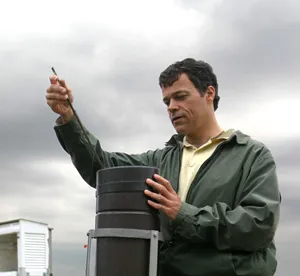Matthew Kelsch - Hydrometeorologist
Dealing with real-world weather problems

Matt Kelsch is one of two volunteers who measure high and low temperature and precipitation each afternoon at Boulder's cooperative observing site, located on the campus of the National Oceanic and Atmospheric Administration.
Carlye Calvin/UCAR
It's no fluke that Matt Kelsch is a meteorologist. He was so interested in weather as a child that his fourth grade teacher actually wrote him special tests on the subject.
"I knew by fifth grade that it was what I wanted to do," he says.
Today Matt is a hydrometeorologist in UCAR's Cooperative Program for Operational Meteorology, Education, and Training. Known as COMET, the program offers courses and computer-based learning to professional meteorologists and students. He spends most of his time developing and delivering educational materials designed for groups ranging from National Weather Service forecasters to the military, private clients, and scientists and professionals from abroad.
"The best way to learn a subject is to have to teach it," Matt says. As a hydrometeorologist, his expertise is in weather events that involve water, such as floods, droughts, and precipitation.
One of Matt's favorite things about his job is dealing with issues that have direct applications. "I like working with the people in the field because they don't have the luxury of spending six months studying a storm," he explains. "They might only have 10 minutes. It gives me an appreciation of real-world forecasting."
Matt does some real-world fieldwork of his own as a local observer for the National Weather Service. Nearly every day, he takes official measurements of precipitation and temperature in Boulder and submits them to the NWS. He also provides the measurements to the Boulder Daily Camera, whose reporters often interview him for stories about drought or snowfall. "It's fun answering their questions," he says.

A funnel-shaped collection device at Boulder's co-op site helps observers make reports of rain or melted snow to the nearest hundredth of an inch.
Carlye Calvin/UCAR
Matt also gets involved in the local community as a coordinator for the Colorado Climate Center's Community Collaborative Rain and Hail Study, better known as CoCoRaHS. Volunteers, both adults and children, take measurements of rain, hail, and snow throughout the state to help gather data for scientific researchers, emergency managers, the media, and schools. Matt is responsible for training volunteers in Boulder, Gilpin, and Broomfield counties. He shows them how to use rain gauges and hail pads, determine the liquid-equivalent of snowfall, and report measurements online.
Matt has a bachelor's degree in meteorology from the State University of New York in Oswego and a master's degree in meteorology from the University of Oklahoma. Fresh out of graduate school, he came to Boulder in 1986 to work in a forecasting laboratory at the National Oceanic and Atmospheric Administration. In 1993, COMET tapped him to be a guest lecturer on radar precipitation, and eventually, he became part of the program's staff.
"I wanted a career in science because I enjoy it so much," he says. When he's called upon to give presentations to elementary school children, he urges them to do the same and pursue what truly interests them. "The point I try to get across is that they choose careers that appeal to them so they'll be happy going to work every day."
Matt plans to stay in the field of education and training and look for more opportunities to combine his hydrometeorological expertise with public service. He adds, "I'll get frustrated if I'm not doing something with a direct application."
by Nicole Gordon
December 2004